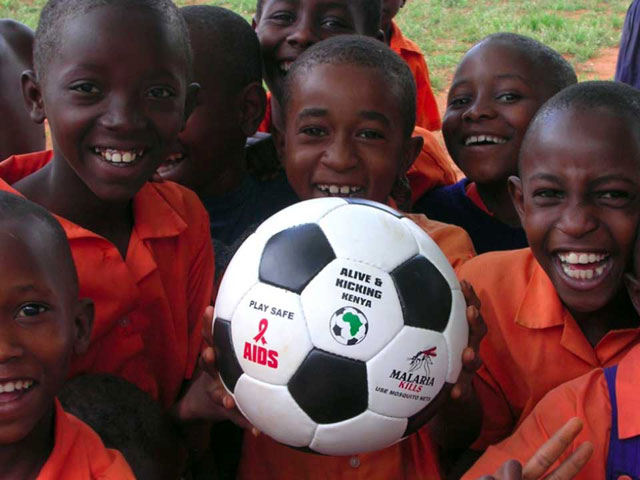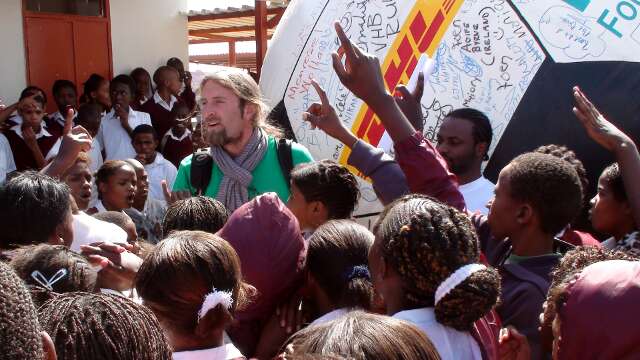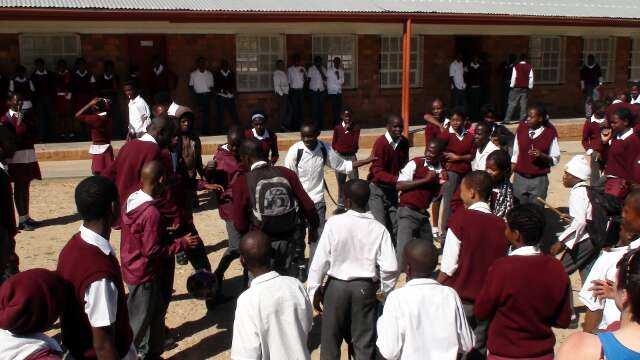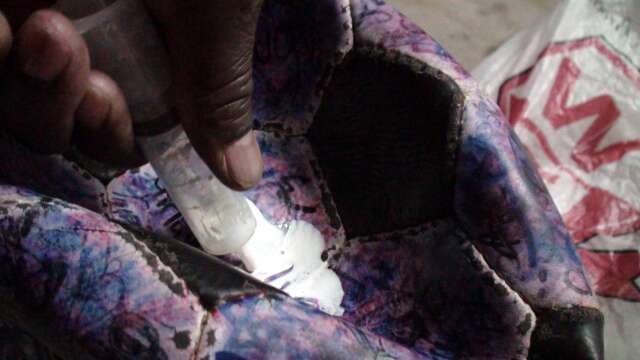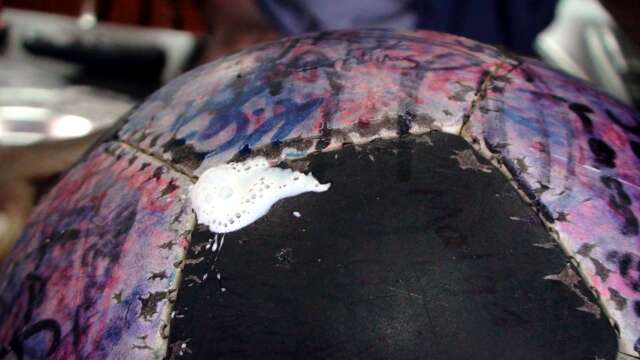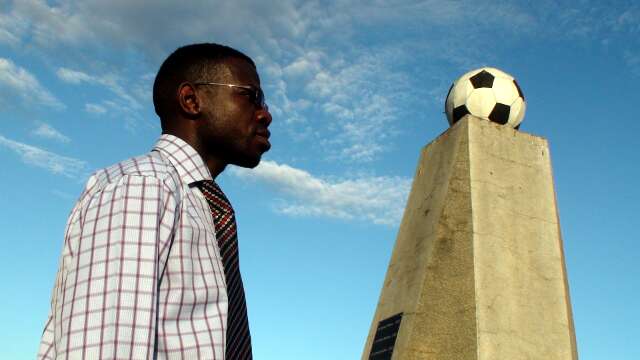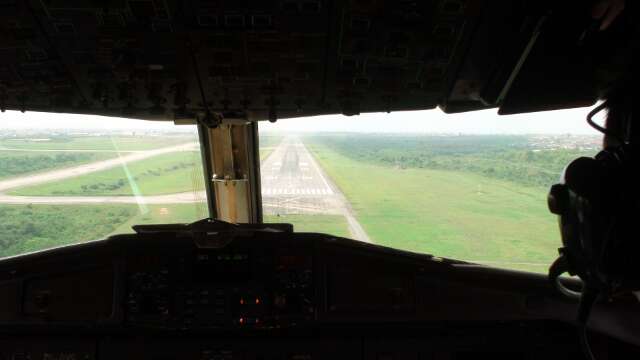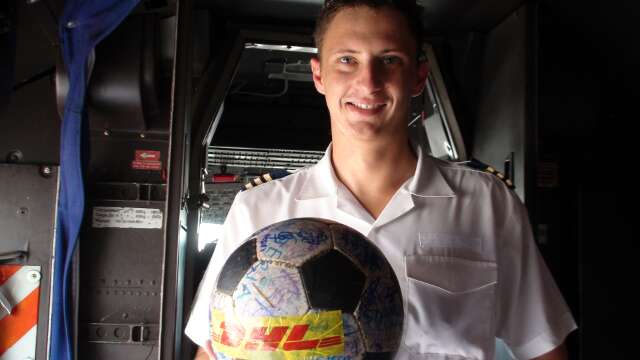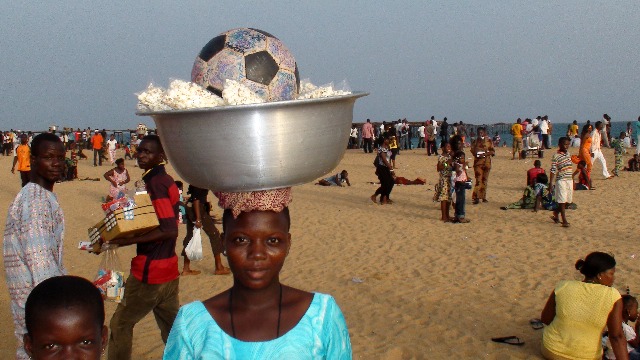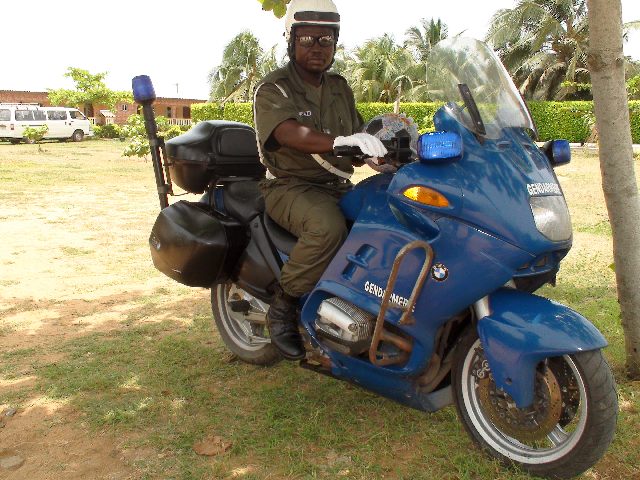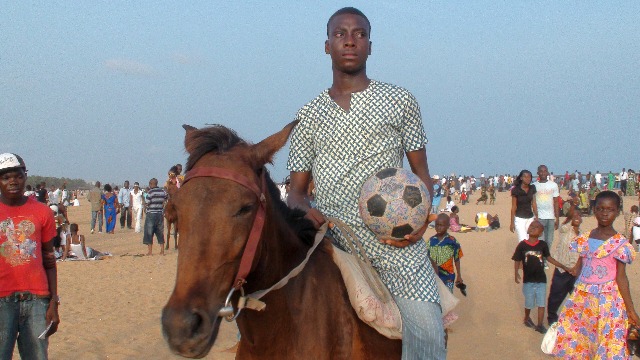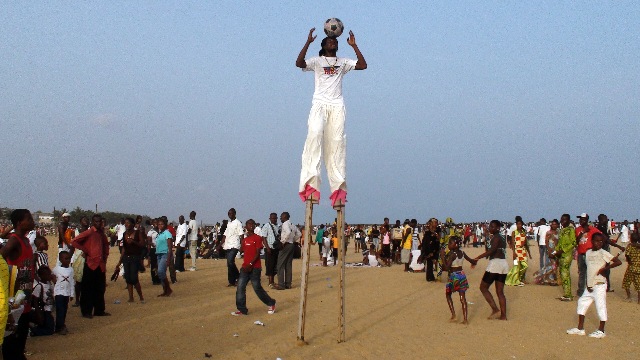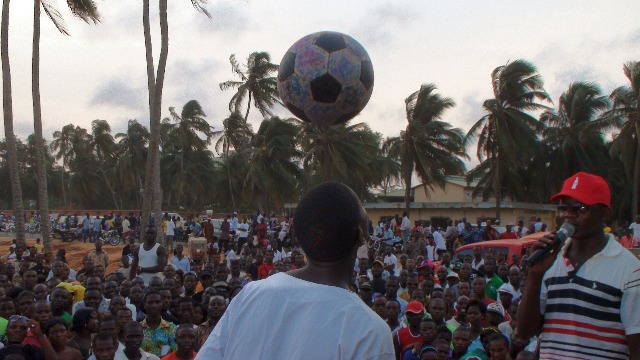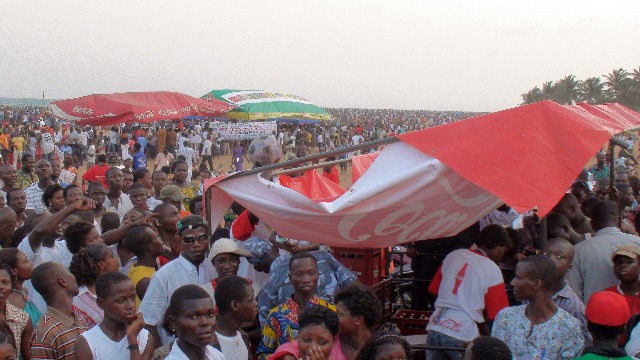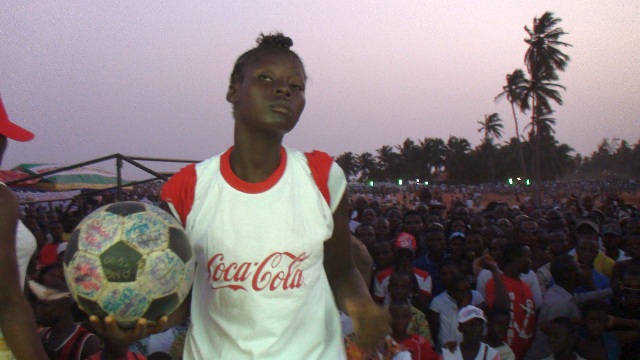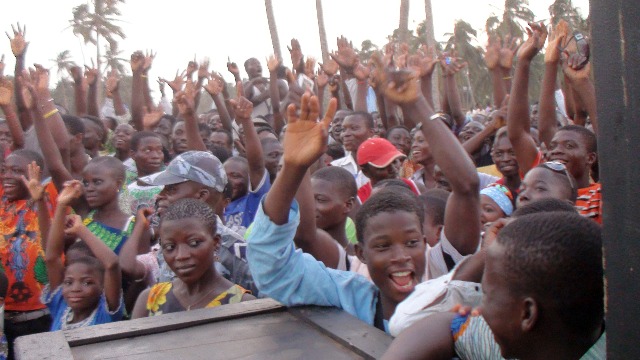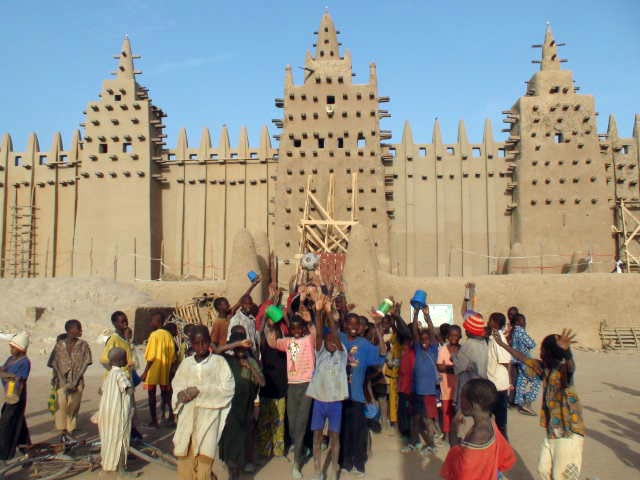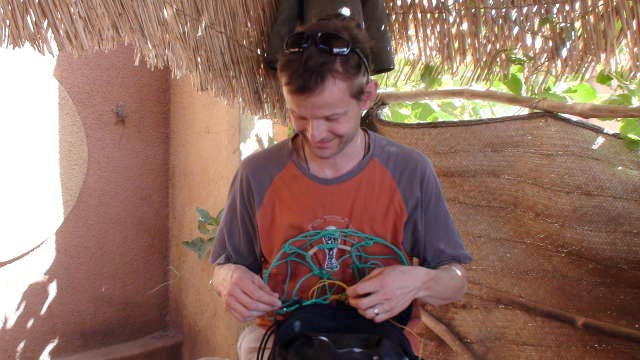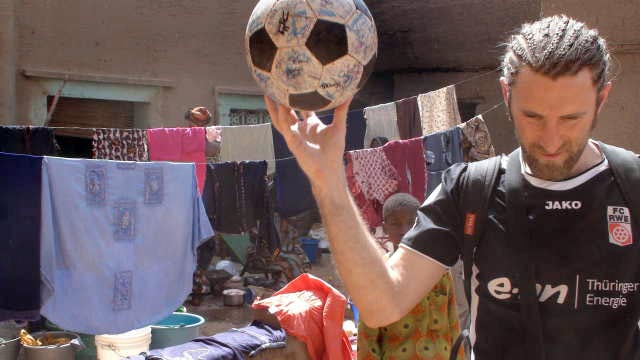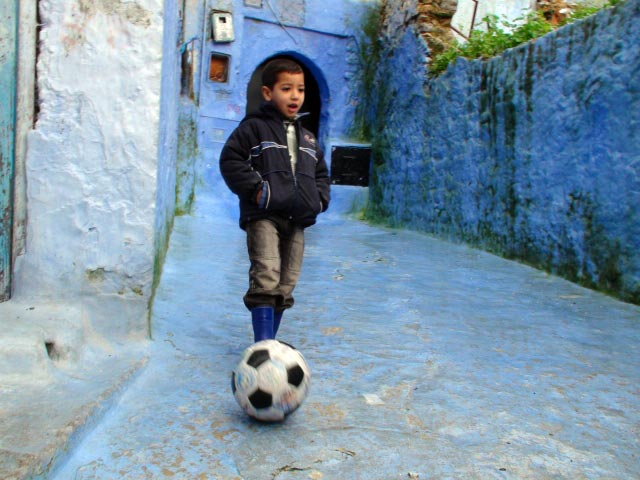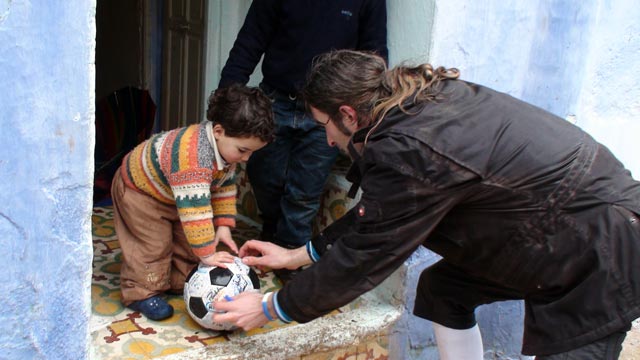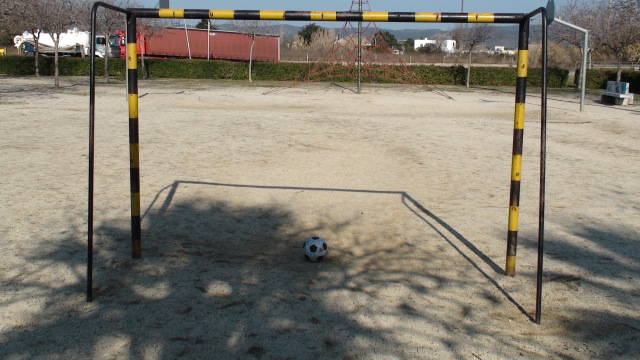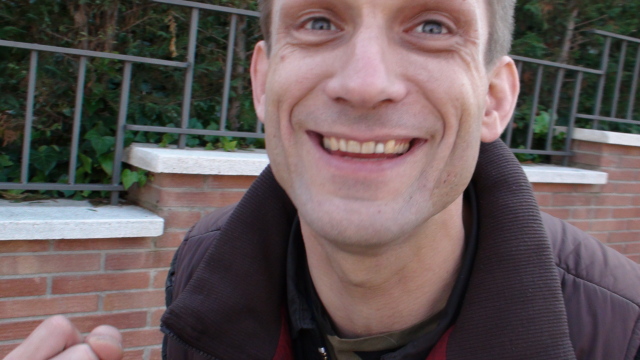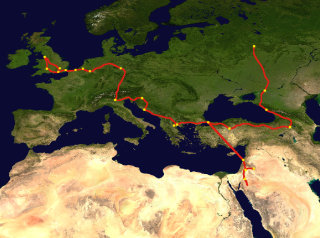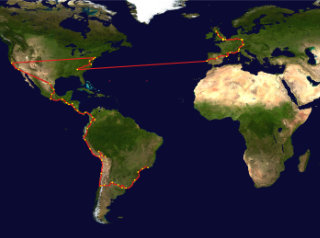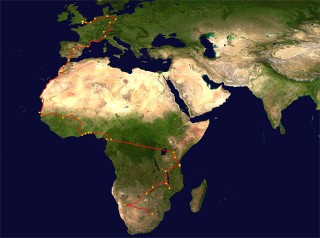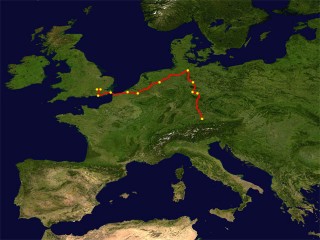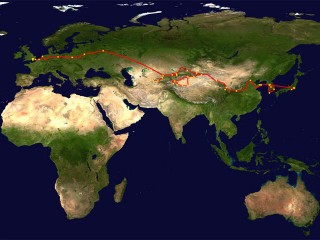We arrive at the school with The Ball and a giant replica. Alarmingly for us, the teachers are nowhere to be seen. Andrew talks to the kids about The Ball, but struggles to make himself heard above the cacophony of chatter.
The children crowd around to sign both balls. And game on… The Ball is kicked around the school-yard in an unruly fashion harking back to the days of village football in England or even the Wall Game at Eton. A huge punt by one young lad and The Ball’s on a classroom roof.
But what’s that? Oh no. The Ball meets a spike on the roof head-on and flops back to earth limp, lifeless and deflated. It needs urgent repairing. We’re a long way from an Alive & Kicking stitching centre and even further from The Ball doctor in Douala. What to do?
We’re recommended a cobbler and that seems like the sensible solution until we hear about a technique for fixing bike punctures. The answer is simple — pump a white sticky substance into The Ball with a syringe.
Shake The Ball about, pump it up, bounce it around. And hey, presto, it rolls again…
The Ball was dead. Long live The Ball.
Back in Libreville in April, Andrew and The Ball took off on a DHL cargo flight headed for Douala, Cameroon. On the 28th of April 1993 another flight took off from that very airport carrying the greatest ever Zambian football team. The plane crashed and everyone on board perished. Today, we remember those fallen heroes as we visit the memorial to them at Independence Stadium in Lusaka. We pay our respects and find out more about what happened.
After refuelling successfully in Gabon the plane took off. What happened next has laid the foundations for many a conspiracy theory. A fisherman reported a huge explosion and saw the plane go down. This man was the only eyewitness and within a week he was dead. His death raised the bar, the Zambian people wanted to know what really happened. Because it was a military aircraft, there was no black-box on board and no way to find out the reason for the crash without the help of Gabon’s Government, and this has not been forthcoming.
The version that is most popular today is that one engine caught fire, the pilot made a mistake in shutting down the good engine instead and the plane crashed. But we still do not know exactly what happened.
What we do know is that players, coaches, administrators, and journalists were all on board. Their remains were brought home and buried right here outside of the national stadium. The monument here, and the graves of the fallen, are a shrine. The Zambians still mourn the loss of those heroes. They still come here, 17 years on, to pay respect to the dead, and they still sing songs about those players at every home match in Independence Stadium. And they still wonder what might have been.
Today, we mourn those players as the sun goes down. Then, together with emotional Zambian football officials, we enter Independence Stadium, accompanied by twenty barefoot kids. Accompanied by a national team striker, we kick The Ball on the pitch. The ear to ear smiles on the faces of the youngsters brighten up the atmosphere. They are living the dream…
“Normally this pitch if reserved for the professionals and the national team. We are making an exception today for you and The Ball.”
Another day, another DHL cargo flight — this time a short hop lasting just 30 minutes from Benin to Lagos, Nigeria.
The Ball and Andrew arrive in Lagos. Nigeria is the 20th country en route to Johannesburg. What awaits them in Nigeria? Andrew is slighty worried as Nigeria has been in the news recently for the kidnapping of foreign nationals. The Ball is relaxed as ever.
Togo is safe, almost too safe. There is a police escort, ready to take me and The Ball to every event and there is a minder, sitting outside of my hotel room ready to protect The Ball from would-be thieves.
The Togolese government has got heavily involved in the Ball’s journey; we have met top dignitaries including the Prime Minister, and everyone is very concerned to make sure that The Ball doesn’t go missing in Togo. I imagine that the concern stems from the African championships in Angola in February and the machine-gunning of the buses carrying the Togolese football team. That issue is still a hot one in Togo and very politicized.
Losing The Ball in Togo on Togolese watch is not in their interests. Our philosophy is that The Ball must be played with as often as possible and by as many people as possible. The spirit of The Ball is about trust. Sure, the playing of The Ball to a stranger contains an element of risk. Yes, someone could try and steal The Ball but that is very unlikely. It is more likely that the person receiving The Ball will smile and play. The interactions we are having are overwhelmingly positive. These random encounters are what The Ball is all about.
Against the best intended advice I take The Ball to the Coca Cola sponsored event at the beach. A man on horseback rides The Ball up and down the beach.
Acrobats on stilts perform with The Ball
A woman carries The Ball in a basket on her head
The Ball is juggled in a Coca-Cola sponsored competition on a stage with a crowd in excess of 2000 people watching on.
During the juggling competition The Ball ends up in the crowd. Where is it? Panic sets in. Ohhhh, there it is…
And as the sun goes down young men and women dance freestyle with The Ball.
Put your hands up for The Ball
We arrive in Djenné as the sun is going down, after a gruelling 14 hour bus ride from Bamako.
Djenné is basically an island surrounded by the Bani river, a tributary of the Niger. To access Djenné, one needs to take a short ferrry ride across the Bani and then a meadering dirt-road into town. The town is a wonderfully close-knit collection of fantasy mud buildings. The central element in this deeply religious muslim community is the world’s largest mud building — the Grand Mosquée. As the sun rapidly and vertically descends, we enter town through a tiny windy road and the side streets look perfect for a pied-piper style kickabout. We are beaming. What potential! Tomorrow awaits.
Our Dutch bus pulls up in the main square, immediately in front of the Grand Mosquée. We have been dreaming about visiting this place for years. Yet just a few days ago it was looking like we wouldn’t have the opportunity after all. Special Olympics, overwhelmed with enthusiasm for The Ball’s arrival, had planned a schedule so full of events that we were going to have to skip it. Christian put his foot down: “You guys are going to Djenné. If you don’t go it’s like visiting Paris and not seeing the Eiffel Tower. Or going to London and not watching a Hammers game.” How dare we not visit Djenné!
We clamber out of the bus and are immediately surrounded by a swarm of people. Some want to sell us food, others are tour guides for Djenné and the Dogon Country trying to hook us, others are hungry children begging for money. The scene is a familiar one, but what follows is not. The Ball is in its net on Andrew’s back. It is the net that Phil carried The Ball in in 2002 and modified in Bamako to fit Andrew’s backpack. Andrew decides to take The Ball out and pass it to some of the kids. This has been the usual case in Mali.
But this time there is a misunderstanding. The kids assume that The Ball is a gift. In no time, about thirty of them are fighting tooth and nail for it. A dust cloud envelops us all. The locals are watching on with interest. It is getting nasty. There are pushes here and even punches there. Andrew, realising his error, goes in after The Ball. And eventually recovers it. But no without a fight…
We soon discover that the children here are actually used to being gifted balls by foreigners. It seems that many of the tourist guidebooks recommend giving a football to a child. Mali, like the rest of Africa, is football mad, but these kids are too poor to buy their own footballs. We decide that, in future, before The Ball is unveiled, we must first attempt to explain what The Ball is all about.
Long journeys, desert dust and open sewers have left The Ball feeling and smelling terrible. It is now dirty — very dirty — and it gets a thorough clean in Djenné. It scrubs up well after its recent ordeals.
So we’re out and about filming a sequence with The Ball in the blue backstreets of Chefchaouen, blues made even more vivid by the pelting rain…
Andrew engages some kids in a kickabout and somehow The Ball gets kicked into their granny’s flat…
She promptly decides that it now belongs to her grandson…
A dramatic and rather tense rescue mission follows…
The Ball recovered, but touch and go for a while there…
“Where is my bag? Where the — — is my bag?”
“What’s in the bag?”, I asked.
“Ohhhh, nothing important… just my filofax, my passport, my credit cards. Everything.”
Ironically, we’d just been listening to the Hitchhikers Guide to the Galaxy, whose cover says “Don’t Panic” in big friendly letters — but I was panicking. Christian seemed to be panicking too…
The sun had been shining and we had been making good progress towards Valencia. The Ball seemed happy enough too: it was still on a high after rolling around on the grass pitch-side at the Nou Camp yesterday.
We had stopped earlier as we were leaving Vilanova, a random football moment had suddenly appeared. Out of the car, camera at the ready, Christian put his bag down to kick The Ball. Elaborately-dressed children enjoying carnival season marched by singing and chanting. 150 kilometres later, ready to feed our caffeine habit, he realised he’d left his bag back there in the park.
After back-tracking to Vilanova, a friend who speaks Catalan called the police. And you know what? Someone had turned in the bag… And, nothing was missing…
Bill Hicks liked to say that “life is a ride”… but our ride has taken us up and down this toll road two too many times today. As I write this we are speeding off along the coast towards Valencia — again. Adreneline is still rushing like the gusts of wind outside. What a ride it’s been today.
“It’s not Friday the 13th is it?”, asks Christian as I type away. He suggests paying a Homage to Catalunya for lettting him off so lightly for such a grave lapse of concentration… I tend to agree. The ride continues as we head south.
Friday the 12th — lucky for some.

